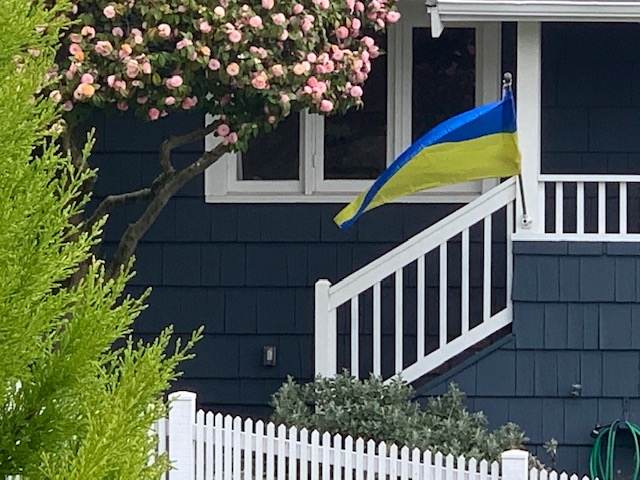My neighbors across the street always have a banner flying from their porch. Sometimes they are holiday related, but mostly the colors of various sports teams. Many are international, thanks to their son's passion for soccer. A few days ago they put up a Ukrainian flag. Now, as the news from the radio on my right makes me despair, this view out my window on the left gives me hope.
Everywhere I glance — social media, art, famous monuments around the world, the emergence of spring — I see blue and yellow. I doubt all are intentional signs of support for Ukraine in this escalating struggle, but many are. A vendor at Seattle's Pike Place Public Market told me he had just ordered sweaters from Guatemala knit with a row of Ukrainian flags around the chest. An artisan shop in northern Wisconsin is turning out 40,000 blue-and-yellow candles.
I wonder if displays like this, coming from those of us watching at a safe distance, do any good. Then I read a news report or hear a social media plea from from those in the blood of the war expressing their gratitude for any show of support — and asking for more. They want Russian President Vladimir Putin to know how little of the world is on his side, or even remotely neutral. Of course, what the Ukrainians really want is to go home and pick up the shards of their lives. To do that, they argue they need more military aid.
The clamor for weapons keys into reports about American civilians who are finding their way to Ukraine. They aren't just those who want to provide help with food and medicine at refugee centers, but more and more who want to pick up arms. Welcome warriors? Romantic freedom fighters? Thrill-seeking mercenaries? Labels are a convenient shorthand. But labels never tell a whole story.
Humanitarian officials are warning about the perils of war tourism. It's akin to poverty porn or any situation where dabblers parachute into humanity's underbelly without paying the full costs. They may travel with the best of intentions but without thinking through the possible consequences. They too, will need food, water, shelter, transportation and, possibly, rescue.
Journalists are often accused of trading on tragedy. We run headlong into places others seek to escape. We arm ourselves with notebooks and cameras and maybe a helmet and Kevlar. I've met journalists who seem wired to work the most dangerous assignments; I've talked to some who admit they can get addicted to the adrenalin and sense of mission.
I've never met one who does it for personal glory.
The imperative of pre-reporting
When we do head into necessary danger as journalists, we should do it with clear purpose and as much of a plan as possible. Ideally, we are backed by institutional support. Mainstream news organizations pay a lot for war-zone insurance coverage, and build networks to be deployed if staffers need help. Freelancers operate without that formalized structure, but those I've met in the field are smart about linking up with other journalists and newsrooms. While none of that eliminates risk, neither is it exploitation.
I had two recent conversations with people eager to travel to Ukraine. One is a former journalist now trained as a nurse. She's covered challenging stories before. She knows enough to connect with a working relief agency on the ground, likely on the Ukraine-Poland border, and to understand the limits of her role. Her dual worlds as nurse and reporter could yield valuable storytelling from inside an overwhelmed aid effort.
The other conversation was with an editor who has been asked to write a sponsor letter for a man hell-bent on going to Ukraine with his camera. The man is, I'm told, a skilled amateur photographer. That's no guarantee he knows what it takes to pop into a world without contacts or without a plan. It would be too easy for him to become one more person taking up stressed resources, one more person who needs rescue when so many others wait for none that comes.
I don't question the man's sincerity. Civilians have flooded into war zones throughout history to stand against oppression. Consider the American Revolution, the U.S. Civil War, the Spanish Civil War to name just a few. Now the imbalance between Russian and Ukrainian military might means everyday residents are called to defend their country, forming what amounts to a citizen militia.
Ukraine needs combatants on the ground. The politicians need diplomatic channels. The rest of us need first-hand accounts as we wrestle with our responsibility. Witness is a crucial weapon.
But as with most challenges in life, passion and action need to be backed up with reporting and common sense. |
|

